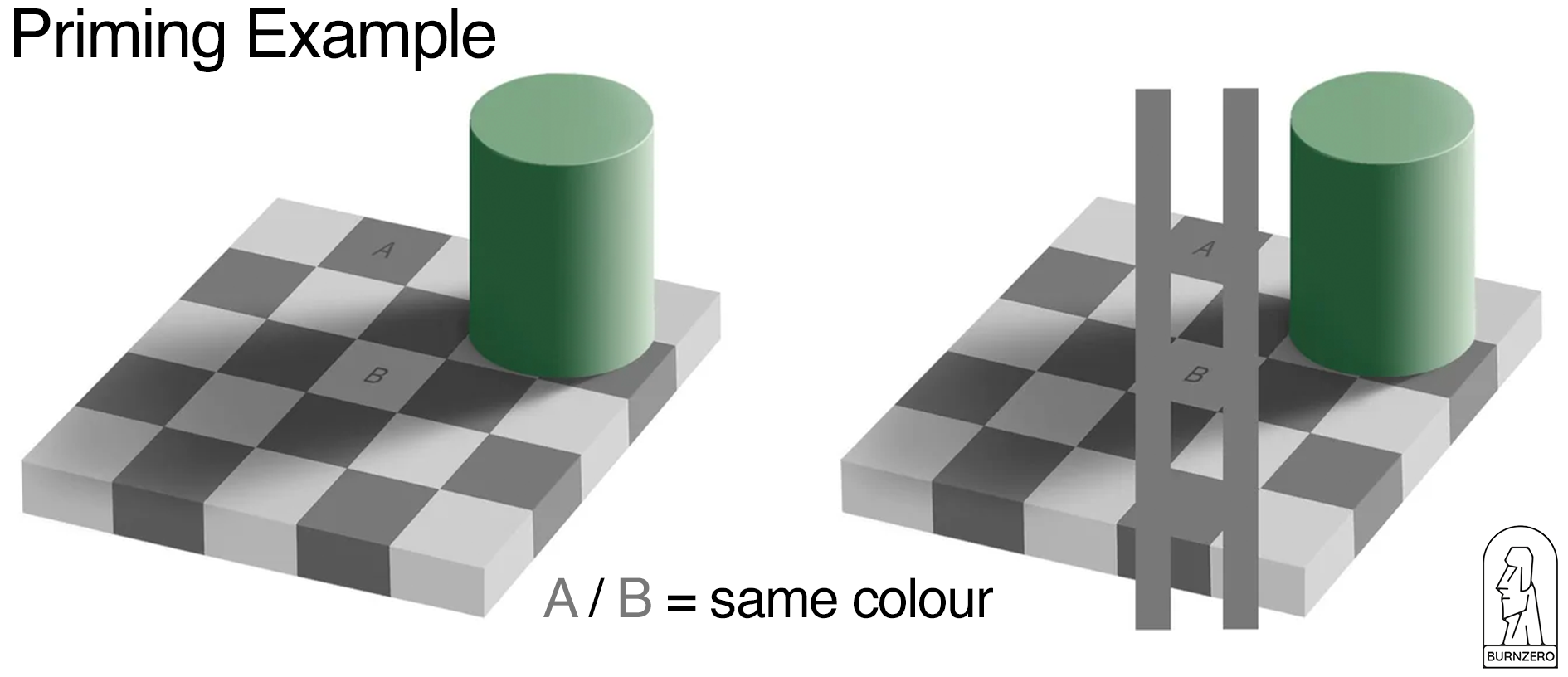Priming
Priming is when exposure to a particular stimulus (such as a word or an image) influences the response to another stimulus that follows shortly after. In other words, the initial stimulus "primes" the brain to interpret subsequent information in a certain way.
For example, if you are shown the word "doctor" and then asked to complete the word "N _ _ S E", you are more likely to say "nurse" than if you were shown a different initial word. This is because the word "doctor" primes your brain to think of medical professions, which then makes "nurse" a more accessible response.
Another example of psychological priming, as seen below, is where an element within an image primes your mind to perceive something that is not true. Both colours A and B are identical as proven to the image on the right, however, in the image on the right B looks darker as subconscious mechanisms are altering your perception.
Priming can also work in more subtle ways, such as when exposure to framed media which can influence our attitudes, behaviors, and decisions without us even being aware of it. Priming is a well-established phenomenon in psychology, and is used extensively in, advertising to influence people's perceptions and behavior.
Priming Examples
Optical Illusions

A simple priming example is this picture to the right that contains 16 squares aligning horizontally called the Coffer Ambiguous Figure (See Figure 1). The image could also show 16 circles aligned horizontally if you were not primed via the previous statement.
Psychological Experiment
A more complicated example of priming is a study conducted in 1999, which saw a group of Asian-American women students entering a room for a math test.
But before the test, they had to fill out a form, the first group had questions on gender-related issues like what’s their gender, opinions about co-ed dorms, etc. The second group’s questions were about ethnicity such as what their ethnicity was, what languages they spoke at home, or when their families moved to the US. And there was a control group that answered questions unrelated to ethnicity or gender.
Now, all groups were equally talented. The math test was the same. But the group that answered questions about ethnicity got significantly higher results. And the gender group got the worst.
Why?
Because we all know about stereotypes. Even though we don’t believe in them. When it comes to math, the stereotype is that Asians are good at it while women are not. So students who were primed that they were Asians performed better. And students who were reminded that they were women performed worse. The subtle power of the priming effect. The study was enlightening as everybody knows stereotypes affect how we see other people but nobody thought they’d also prime our own behavior and performance.
As our brains are energy frugal, our minds use shortcuts to make sense of new information. Whether it’s the anchoring effect or association bias. Priming is another shortcut (or heuristic). So one stimulus can influence our behavior about a following, related stimulus. It’s like our mind keeps the words and memories in clusters. And when you get a few cues from a certain cluster, your next actions tend to fit into that. In the example, “Asian” is in the same cluster as “high Math skill” or “smart.” And that created a high expectation for the “Asian” students — hence they performed better.
Psychedelic Priming
Priming is a proven psychological method of adjusting ones pre conceived ideas about a process which psychosomatically effects the final outcome. By adjusting the different expected points in psychedelic therapy, priming can be used to increase the Pygmalion effect, a psychological phenomenon in which high expectations lead to improved performance in a given area[1].
References
- ↑ Modalities of the psychedelic experience: Microclimates of set and setting in hallucinogen research and culture. Ido HartogsohnFirst Published July 12, 2022 Research Article. https://doi.org/10.1177/13634615221100385

